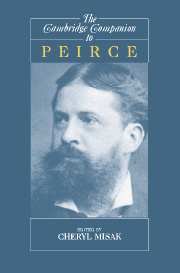Book contents
- Frontmatter
- 1 Charles Sanders Peirce (1839-1914)
- 2 Peirce's Place in Pragmatist Tradition
- 3 Peirce and Medieval Thought
- 4 Reflections on Inquiry and Truth Arising from Peirce's Method for the Fixation of Belief
- 5 Truth, Reality, and Convergence
- 6 C. S. Peirce on Vital Matters
- 7 Peirce's Common Sense Marriage of Religion and Science
- 8 Peirce's Pragmatic account of Perception
- 9 The Development of Peirce's Theory of Signs
- 10 Peirce's Semeiotic Model of the Mind
- 11 Beware of Syllogism
- 12 Peirce's deductive Logic
- Note on References
- Bibliography
- Index
2 - Peirce's Place in Pragmatist Tradition
Published online by Cambridge University Press: 28 May 2006
- Frontmatter
- 1 Charles Sanders Peirce (1839-1914)
- 2 Peirce's Place in Pragmatist Tradition
- 3 Peirce and Medieval Thought
- 4 Reflections on Inquiry and Truth Arising from Peirce's Method for the Fixation of Belief
- 5 Truth, Reality, and Convergence
- 6 C. S. Peirce on Vital Matters
- 7 Peirce's Common Sense Marriage of Religion and Science
- 8 Peirce's Pragmatic account of Perception
- 9 The Development of Peirce's Theory of Signs
- 10 Peirce's Semeiotic Model of the Mind
- 11 Beware of Syllogism
- 12 Peirce's deductive Logic
- Note on References
- Bibliography
- Index
Summary
Your intensely mathematical mind keeps my non-mathematical one at a distance. But so many of our categories are the same that your existence and philosophizing give me the greatest comfort.
Perry 1935/1936: I, 224; James’s letter to Peirce, March 27, 1897Your mind and mine are as little adapted to understanding one another as two minds could be, and therefore I always feel that I have more to learn from you than from anybody.
CP 8.296; Perry 1935/1936: II, 431; Peirce’s letter to James, October 3, 1904INTRODUCTION
“Who originated the term pragmatism, I or you? Where did it first appear in print? What do you understand by it?” Charles Peirce asked his friend William James in a letter on November 10, 1900 (CP 8.253; Perry 1935/1936: II, 407 n5). On November 26, 1900, James replied: “You invented 'pragmatism' for which I gave you full credit in a lecture entitled 'Philosophical conceptions and practical results.'” The published version of that lecture (1898) is very likely to have been the first place where the term “pragmatism” was used in print, and James was the first philosopher known as a pragmatist. The pragmatist movement was largely developed by James, although Dewey, Royce, and even Schiller may have had an original and independent role to play in its formation. Nonetheless, James referred to Peirce's earlier unpublished usage of the term and acknowledged Peirce as the first to formulate a pragmatistic doctrine in the discussions of the Cambridge “Metaphysical Club” in the early 1870s.
- Type
- Chapter
- Information
- The Cambridge Companion to Peirce , pp. 27 - 57Publisher: Cambridge University PressPrint publication year: 2004
- 15
- Cited by

